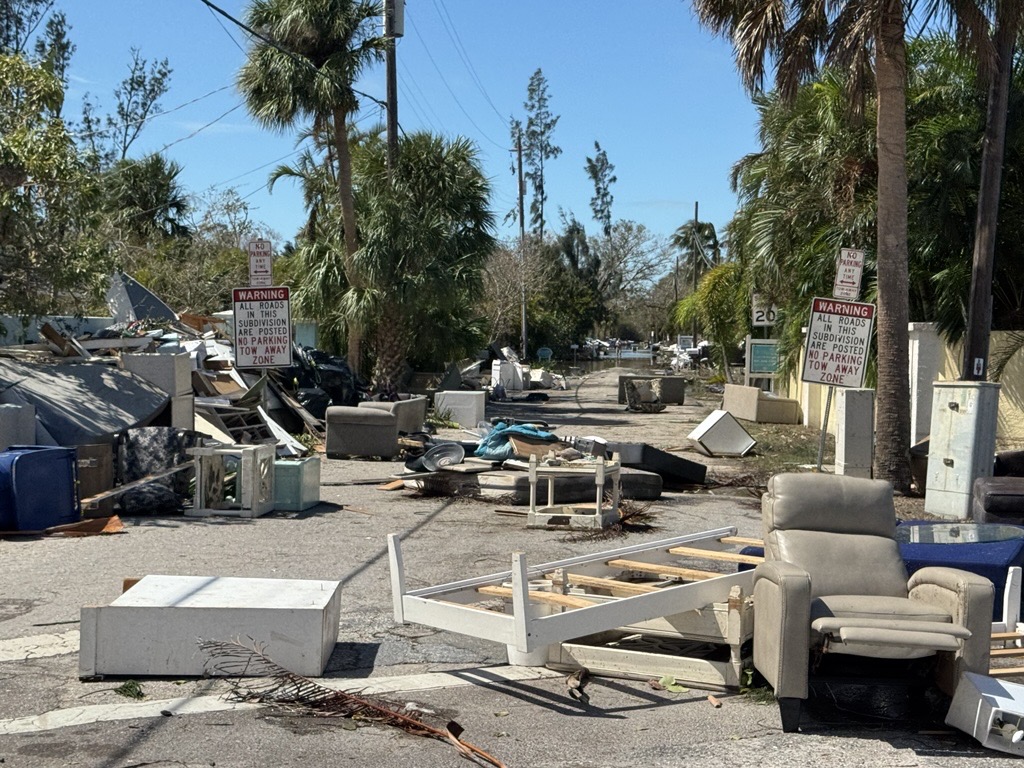What we’re watching: Weekly disaster update, October 14

Editor’s note: Due to a team retreat, there will be no “What We’re Watching” blog post next week. The next edition will be published on Oct. 28.
We know all too well that disaster can strike anytime, anywhere in the world. Some disasters make headlines; others do not. Here at the Center for Disaster Philanthropy (CDP), we monitor the status of disasters worldwide and compile a list of the ones we’re tracking weekly, along with relevant disaster-related media coverage.
Here’s what we’re watching for the week of Oct. 14, 2024.
New or Emerging Disasters
Flood – Sudan: Monsoon rains in August and September present yearly challenges in Sudan, often flooding riverside communities along the Nile. This year, severe flooding in Sudan has displaced more than 241,000 people and rendered 15 main supply routes impassable. The water has washed away bridges and other essential infrastructure links, including the Azum Valley Bridge and the Arbaat Dam, effectively separating West Darfur from other states in the region. This has made it impossible to deliver critical humanitarian aid into and out of West Darfur. Given the immense crisis in Sudan due to the civil war, this is of significant concern.
For more information on Sudan and how you can help, see our Sudan Humanitarian Crisis disaster profile and CDP Sudan Humanitarian Crisis Fund.
Fires – Montana: The Railroad-Daly fires near Hamilton, Montana have been burning since July 25 and Aug. 18, respectively, but are now tracked as one fire. The fire is approximately 56% contained but continues to expand, reaching 11,700 acres as of Oct. 14. Evacuation warnings were issued in Ravalli County on Oct. 10, and trail closures were issued in Bitterroot National Forest and Beaverhead-Deerlodge National Forest. The Skalkaho Pass remains closed due to falling timber, boulders and debris from the Daly fire. Other roads within the area are closed as the fire moves northeast.
For more information and how you can help, see our North American Wildfires disaster profile and CDP Disaster Recovery Fund.
Previous/Ongoing Disasters
Hurricanes Helene and Milton – United States
Hurricane Milton made landfall on Siesta Key, a barrier island off the coast of Sarasota, Florida, on Oct. 9 as a Category 3 hurricane with 120 mph winds. About two feet of rain fell along the northern side of the storm, in addition to inland flooding from the storm surge on both of Florida’s coasts. The storm surge reached about 6 feet maximum rather than the 10-15 feet predicted because the hurricane wobbled away from its original path, hitting Sarasota directly rather than Tampa Bay.
As of Oct. 15, 24 people were killed due to the storm, and 1,600 people had been rescued from floodwaters. Many of these deaths were caused by powerful tornadoes that spawned along the circumference of the hurricane, well inland from the initial flooding and storm surge. Almost 203,000 customers were still without power as of Oct. 15 at 8:30 CDT.
Additionally, Hurricane Milton is the latest in a series of profound setbacks for citrus growers in Florida. As many as three million oranges may have been lost from the storm and prices are already rising. This will significantly impact the farmers and migrant workers who rely on these farms for their livelihood.
Hurricane Helene caused the third-highest number of deaths from a hurricane in the U.S. since 2000, behind Hurricane Maria in 2017 and Hurricane Katrina in 2005. As of Oct. 9, Hurricane Helene has killed 238 people. There are serious concerns for the safety of FEMA staff, and the government pulled workers from the field in some areas of North Carolina due to threats to their safety.
In terms of financial damages, AccuWeather increased its estimate of the total economic loss from the storm to between $225 billion and $250 billion.
For more information, see CDP’s 2024 Atlantic Hurricane Season disaster profile. CDP also hosted a webinar on Oct. 3: Hurricane Helene: How funders can support recovery. Watch the recording.
Support long-term recovery of communities affected by Hurricanes Helene and Milton through the CDP Atlantic Hurricane Season Recovery Fund.
Wildfires – Brazil: Ongoing fires in the Amazon and the Brazilian Pantanal, the world’s largest tropical wetland, have destroyed more than 7,000 square miles in 2024, an area the size of New Jersey. Many fires are burning across South America, but 76% are in Brazil.
As of Oct. 11, the ongoing destruction caused by the wildfires in Brazil has forced 10,700 people to evacuate and has directly affected 18.9 million people. At least five people have died, and many have suffered from smoke inhalation and disrupted health services.
For more information and how you can help, see our 2024 Brazil Wildfires disaster profile and the CDP Global Recovery Fund.
H5 Avian Influenza – United States: In September, the first case of H5 avian influenza in a person without animal contact was confirmed in an individual in Missouri. The U.S. Center for Disease Control and Prevention announced on Sept. 6,
“It’s also the first H5 case detected through the country’s national flu surveillance system rather than targeted surveillance of the ongoing bird flu outbreak in animals.”
As of October, California has recorded six cases of bird flu, all originating from the same dairy farm in the Central Valley, bringing the total number of cases in the United States to 20 since April 2024.
Extreme Hunger – Haiti
This standing section will update readers on areas facing extreme hunger.
At the end of September, Haiti reached a sad and historic statistic. The Integrated Food Security Phase Classification (IPC) analysis shows that one in two Haitians – 5.4 million people – face acute hunger. More than two million people are experiencing emergency levels of hunger (IPC 4), and 6,000 internally displaced people are experiencing catastrophic levels of hunger (IPC 5).
Haiti is the poorest country in Latin America and the Caribbean, and it is one of the poorest countries in the world. It has endured several environmental disasters in the last couple of decades and faces political upheaval and gang warfare. These factors, combined with displacement, unrest, increasing prices and low crop yields, contribute to the hunger crisis.
CDP resources include:
- Our Global Hunger Crisis Fund supports recovery from hunger and famine worldwide.
- Our Haiti Humanitarian Crisis disaster profile summarizes environmental issues and other crises affecting the country to guide funders in how to help.
- Our Famine Issue Insight explores meanings, statistics and levels of hunger definitions.
- Our Nutrition Issue Insight looks at the impact of the lack of food on a person, as well as food and nutrition needs after disasters.
In addition to the disasters listed above, we actively monitor the following disasters or humanitarian emergencies. For more information, see the relevant disaster profiles, which are updated regularly.
- 2024 Central and Eastern Europe Floods
- Sudan Humanitarian Crisis
- 2024 West and Central Africa Floods
- 2024 South Asia Floods
- Horn of Africa Hunger Crisis
- Gaza-Israeli Humanitarian Crisis
- Super Typhoon Yagi
- Afghanistan’s Humanitarian Crisis
Complex Humanitarian Emergencies – Central African Republic
Many places worldwide are experiencing emergencies caused by conflict, climate change, drought, famine, economic challenges and other conditions that combine to create a complex humanitarian emergency (CHE). CDP maintains complete profiles on several CHEs, and what CDP considers Level 1 CHEs are profiled in this weekly blog post and tracked.
The crisis in the Central African Republic remains one of the most neglected in the world, according to the Norwegian Refugee Council. After the election in 2020, violence in the region exploded. Now, one in five Central Africans have been displaced, one in two face food insecurity, and nearly 300,000 CAR children under five suffer from acute severe malnutrition.
Additionally, outside of CAR’s borders in Sudan, fighting between the Sudanese Armed Forces and the Rapid Support Forces has continued since the conflict began there in April 2023. Since then, 31,649 forcibly displaced people from Sudan have arrived in the Central African Republic, including 25,491 Sudanese refugees and 6,158 Central African returnees, compounding the displacement and refugee crisis in CAR.
Some of the country’s 6.1 million people have had to move several times from one commune to another. As of August 2024, there were approximately 455,533 internally displaced persons in CAR, a 2.5% drop since July 2024. However, 5,000 people a month continue to be displaced due to insecurity, and around 750,000 have been displaced abroad for the same reason. Many IDPs have chosen to return to Bria, the center of the country, due to Support to Return programs. The security of refugees in the Bamingui-Bangoran Prefecture, in particular, remains a major challenge due to the presence and activities of armed groups there. Additionally, environmental hazards increase the severe vulnerability of CAR’s population, with flooding and drought contributing to vast displacement.
Amid ongoing conflict, violence against women and girls has increased since 2020 from about 9,200 reported cases to 25,500 as of April 2024. International funding for CAR has steadily decreased, with gender-based violence receiving some of the least support. People living with disability face compounding vulnerabilities in the region, with limited access to basic health care services. And financial stress is a significant contributor to the worst types of exploitation of children, with forced labor, sexual violence and child marriage becoming much more prevalent with skyrocketing fuel and food prices, weakened supply chains and international crises.
In February 2024, the CAR government and the Humanitarian Country Team launched a plan requesting $367.7 million. As of Oct. 15, 2024, the Central African Republic Humanitarian Response Plan has raised just $202 million of the goal (54.9%).

What We’re Reading
- Evacuating in disasters like Hurricane Milton isn’t simple – there are reasons people stay in harm’s way, and it’s not just stubbornness – The Conversation: “With 1 in 9 Americans facing poverty today, many have limited evacuation options. During Hurricane Katrina in 2005, for example, many residents did not own vehicles and couldn’t reach evacuation buses. That left them stranded in the face of a deadly hurricane. Nearly 1,400 people died in the storm, many of them in flooded homes.”
- Africa’s famous Serengeti and Maasai Mara are being hit by climate change – a major threat to wildlife and tourism – The Conversation: “The Mara-Serengeti ecosystem, which includes Kenya’s Maasai Mara and Tanzania’s Serengeti National Park, is one of the most famous and wildlife-rich areas in Africa.” A multi-sectoral team has been following the weather patterns in the Mara-Serengeti for decades. Their new study highlights the major changes that are happening there and what it may mean.”
- Billion dollar database – climate disasters are looming shocks – Carnegie Endowment for International Peace: “In the first half of the twenty-first century, the world has experienced two primary economic shocks: the 2008 subprime mortgage crisis that started in the United States and became a global recession, and the COVID-19 pandemic that battered the world economy in 2020. There is a third, looming shock that is already starting to play out: a housing and insurance crisis fomented by climate disasters.”
A moment of hope… An orphaned baby beaver named Nibi, who would not have survived in the wild, has won her right to remain in the care of her preferred humans at a wildlife rehabilitation center in Massachusetts.
According to The New York Times, staff at Newhouse Wildlife Rescue in Massachusetts decided that this was the first healthy animal in thousands they felt could not be rewilded. While government officials ordered her release, social media videos showcasing the beaver’s cuteness drew millions of viewers, and fans even circulated a petition to allow her to stay at the rehab center. Eventually, the Gov. Hochul intervened, dubbing Nibi “an educational beaver,” and gave her permission to stay.
